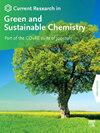Enhanced antibacterial activity of Ocimum sanctum leaf extract mediated hydroxyapatite and hydroxyapatite-iron oxide nanocomposites
Q2 Materials Science
Current Research in Green and Sustainable Chemistry
Pub Date : 2025-01-01
DOI:10.1016/j.crgsc.2024.100439
引用次数: 0
Abstract
Hydroxyapatite (HA) is frequently used in a variety of biomedical applications especially in orthopedics and dental because of its outstanding bioactivity and biocompatibility. On the other hand, HA lacks inherent antibacterial properties, shows poor mechanical strength, and infection issues are still one of the main causes of implant failure. Consequently, antibacterial HA may be a potential material for HA applications. For any potential uses of modified hydroxyapatite, such as in medicine or environmental protection, magnetite (Fe3O4) may be a crucial element because it has good mechanical properties and is preferred in biomedical systems. Moreover, Fe3O4 is biocompatible and basically nontoxic to humans. Therefore, the present study aims to find a novel approach that may improve the antibacterial activity of HA and HA-Fe3O4 nanocomposites and provide low toxicity to humans. The synthesized HA and HA -Fe3O4 nanocomposites were characterized by XRD, FTIR, SEM, EDX, and Zeta potential analyzer. Moreover, antibacterial activity tests confirmed that the utilization of Ocimum sanctum leaf extract as a reaction medium in HA and HA-Fe3O4 nanocomposites synthesis improved antibacterial activity against Escherichia coli and Staphylococcus aureus. This research demonstrates the green synthesis of HA and HA-Fe3O4 nanocomposites using Ocimum sanctum leaf extract by hydrothermal method, opening the door for potential applications in biomedical fields.
竹叶提取物介导羟基磷灰石和羟基磷灰石-氧化铁纳米复合材料的抗菌活性增强
羟基磷灰石(HA)因其出色的生物活性和生物相容性被广泛应用于各种生物医学领域,特别是骨科和牙科领域。另一方面,HA缺乏固有的抗菌性能,机械强度较差,感染问题仍然是种植体失败的主要原因之一。因此,抗菌透明质酸可能是一种潜在的透明质酸应用材料。对于改性羟基磷灰石的任何潜在用途,例如在医学或环境保护中,磁铁矿(Fe3O4)可能是一个关键元素,因为它具有良好的机械性能,并且在生物医学系统中是首选。此外,Fe3O4具有生物相容性,对人体基本无毒。因此,本研究旨在寻找一种新的方法来提高HA和HA- fe3o4纳米复合材料的抗菌活性,并提供对人体的低毒性。采用XRD、FTIR、SEM、EDX和Zeta电位分析仪对合成的HA和HA -Fe3O4纳米复合材料进行了表征。此外,抗菌活性试验证实,利用菟丝子叶提取物作为反应介质合成HA和HA- fe3o4纳米复合材料可提高其对大肠杆菌和金黄色葡萄球菌的抗菌活性。本研究通过水热法制备了透明质酸和HA- fe3o4纳米复合材料,为生物医学领域的潜在应用打开了大门。
本文章由计算机程序翻译,如有差异,请以英文原文为准。
求助全文
约1分钟内获得全文
求助全文
来源期刊

Current Research in Green and Sustainable Chemistry
Materials Science-Materials Chemistry
CiteScore
11.20
自引率
0.00%
发文量
116
审稿时长
78 days
 求助内容:
求助内容: 应助结果提醒方式:
应助结果提醒方式:


